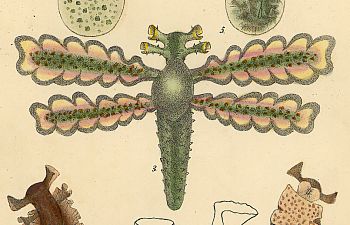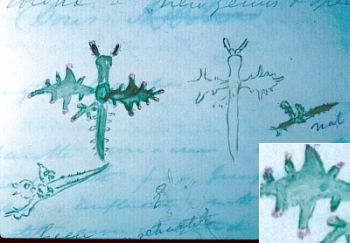What is Lobiger viridis?
November 9, 2001
From: Bill Rudman


To help in the on-going discussion about Lobiger viridis, L. souverbii and L. sagamiensis, here is some background information on L. viridis.
PHOTOS: UPPER: L. viridis (as L. picta, from Pease, 1868, Pl.10, fig. 3. LOWER: Unpublished page from Kelaart's field notes, Ceylon. Natural History Museum, London.
The species was described by Pease from a specimen collected and illustrated in Tahiti by Andrew Garrett. Garrett either had an aberrant specimen, or his sketch was inaccurate, because he described it with 4 rhinophores. As he also sketched a number of aplysiids at the same time, which he correctly gave 4 head tentacles, I suspect his drawing was an error. The nomenclature is somewhat tangled because Pease published three accounts of this same animal. In 1861 (p246) he gave a full description of the external features under the heading "Lobiger ---- ?". In 1863 (p510) he published a short communication noting changes and errors in his previous contributions and named the species Lobiger viridis. In a somewhat puzzling later move (1868) he published a nearly identical description of the same animal calling it Lobiger picta. There is no mention of blue or black lines on the mantle.
Nevill & Nevill (1869) apparently unaware of Pease's name, described a species from Ceylon and also named it Lobiger viridis. This species was based on a shell and renamed by Pilsbry (1896) L. nevilli. It is probably a synonym of Pease's species. The only record I know of a Lobiger from Ceylon, is some unpublished sketches in a notebook of Kelaart's from the early 1800s, which is now in the Natural History Museum, London. As you will see from the drawing it has the deeply indented parapodial flaps apparently chracteristic of Indo-West Pacific animals. In Kelaart's painting [see inset] the reddish pink tips of the branches of the parapodial lobes are very similar to those in Masayoshi Chikako's photos from Japan.
Concerning the presence of black or blue lines on the mantle, Marshall & Willan (1999) note that Heron Id sometimes have dark lines and aometimes do not.
References:
• Pease, W.H. (1861): Descriptions of new species of Mollusca from the Pacific Islands. Proceedings of the Zoological Society of London, for 1861: 242-247.
• Pease, W.H. (1863) Letter. On errors and omissions in former communications. Proceedings of the Zoological Society of London, for 1863: 510.
• Pease, W.H. (1868) Descriptions of marine Gasteropodae, inhabiting Polynesia. American Journal of Conchology, 4(2): 71-80. (Pls. 7-10)
Related messages
-
Lobiger viridis from Gulf of Kachchh
From: Dishant Parasharya, April 13, 2010 -
Re: Striped and unstriped Lobiger viridis together
From: David and Leanne Atkinson, December 8, 2009 -
Re: Lobiger viridis from Kerala, India
From: Dr. A. Biju Kumar, September 7, 2009 -
Slug in Fishtank
From: Jannes Freiberg, January 20, 2006 -
Lobiger from Heron Island mating
From: Julie Marshall, April 25, 2005 -
Re: Lobiger viridis from the Philippines
From: Erwin Koehler, May 23, 2003 -
Lobiger and eggmass from the Philippines
From: Erwin Koehler, April 11, 2003 -
Lobiger from Malaysia
From: Erwin Koehler, January 16, 2003 -
More photos of Lobiger viridis
From: Scott Johnson, November 23, 2001 -
Re: Lobiger sagamiensis from Hong Kong
From: Bernard Picton , November 17, 2001 -
Re: photo of Lobiger cf. souverbii
From: Nishina Masayoshi, November 9, 2001 -
Striped and unstriped Lobiger viridis together
From: Bill Rudman, November 9, 2001 -
Re: Lobiger cf. souverbii from Japan
From: Kathe R. Jensen, November 8, 2001 -
Lobiger cf. souverbii from Japan
From: Nishina Masayoshi, November 6, 2001
